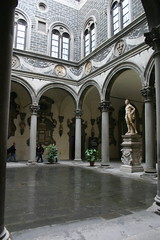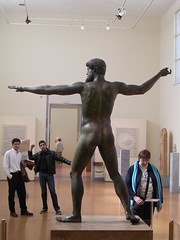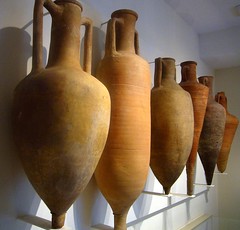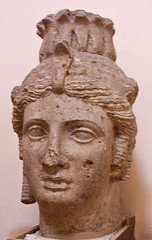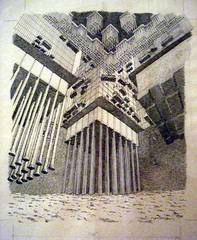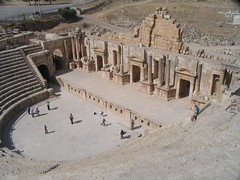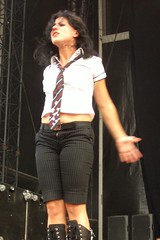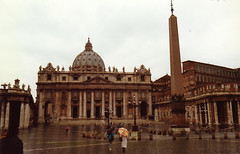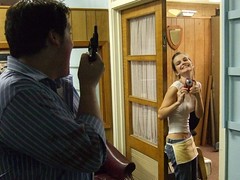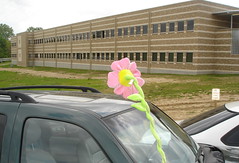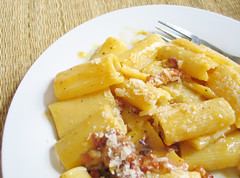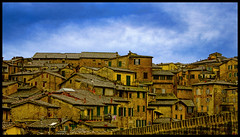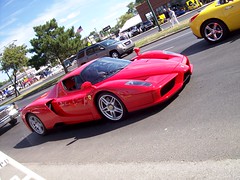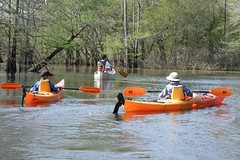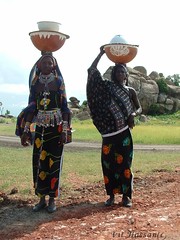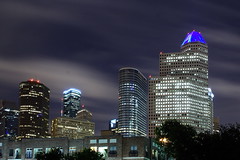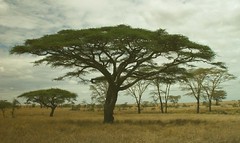Tuscany is arguably Italy's best-known region. The history and beauty of the hilly farmland is legendary. Interestingly, Toyota has named its minivan the Sienna, for a Tuscan town, and Porsche has long had a model called the Carrera, another city of Tuscany. Also in the region: Pisa and Firenze.
My overview of what's important in L'italia:
In the heart of Rome is the temple called the Pantheon, still functioning after some 2000 years.
Ciao! means "hello!" or "bye!" in Italian slang.
From Chianti, a vino of Northern Italy, to chiaroscuro, an artist's term which refers to portrayal through light and shadow, the Italians have an enormous impact on the refined life.
On the other hand there's the Sicilian mafia, the cosa nostra.
The map
* Roma and, within it, the Vatican City. The Vatican is one of the tiniest nations and home to il Pape.
* Napoli / Naples / Neapolis (Gk) Neapolitan ice cream! Home of pizza!
* On the Bay of Naples is the Isle of Capri (goats), one of the most ancient resorts. One of Rome's emperors capriciously used Capri as his capital. *
* Looming above Naples bay is Mt. Vesuvius and nearby is the ancient resort called Pompeii.
* Florence / Firenze / "flower" is the center of the region called Tuscany. The Ponte Vecchio is a bridge over the River Arno which features shops built into the structure. "Florentine" indicates high quality in jewelry, in cooking, in crafts.
* The River Arno flows to the sea through Pisa, famous for its bell tower.
* Venetia / Venizia / Venice, is called the "Queen of the Adriatic." Is this where Venetian blinds originated?
* Milano is a center of the fashion industry and city of fine foods and complex recipes. That's why Pepperidge Farms named their light but fine and imperially slim cookie the Milano.
Why study Italy?
* Natural beauty: the Appenino range, the sea, the fertile fields of the Po River valley.
* History: the eras of the Roman Empire and the Renaissance were periods of extraordinary creativity.
* Cuccina, or cooking. From Fettucine Alfredo to Cannoli.
* Foods such as sausages (salami), olive oil and cheeses (ricotta, parmesan, provolone, mozzarella).
* Textiles and fashionable clothing, shoes and bags: Armani, Gucci, Dolce & Gabana, Prada, Versace, etc.
* Manufactured goods such as the Ferrari, Lamborghini, Lancia and Fiat.
* Art by Michaelangelo, Leonardo da Vinci, Donatello and numerous others.
* Vatican City: the tiny nation that is the center of power of the Roman Catholic church.
* The origins of musical art such as opera, ballet and instrument making. See the pianoforte and violincello.
**
Classroom music ...
"Carmina Burana:" secular Medieval tunes in an opera-like choral production (opera means a "work").
**
Tuscany: a region known for its history, landscapes, vineyards, flowers, fine cooking, art and historic towns such as Pisa, Siena and Lucca. Florence is Tuscany's capital.
Sienna, the orangish-red or brownish-yellow color, takes its name from the soil in Tuscany. See Terra di Siena and Terra Cotta ("baked earth") clay. Remember Roman tiles made of terra cotta?
What American region compares to Tuscany?
Napa Valley, California, above San Francisco bay. It is known for vineyards (Gallo, Almaden), fine cooking and hilly beauty.
Mortar & pestle - used by apothecary or chef to grind and blend herbs or medicines. Gives its name to Sauce Pesto.
Pesto sauce includes basil, parmesan cheese, olive oil, pine nuts (pignoli)and garlic. Pesto is herbally greenish and sweet. It is traditionally eaten over pasta.
Pasta: dough.
Did pasta come to Italy from Germany or China? Marco Polo was the likely importer of a recipe for the food, made simply of wheat (one type being semolina) and water.
Here are selected examples:
canelloni: stuffed tube.
capelletti: "little hats;" stuffed.
farfallette: ribbon/bow-shaped.
fettucine: long egg noodles.
lasagna: widest of the flat noodles.
linguini: "little tongues;" narrow.
macaroni: in tubes.
pastina: disks of pasta.
ravioli: filled squares.
rigatoni: ribbed, tubular.
tortellini: ring-shaped and filled.
vermicelli: "little worms;" thin.
**
Sicilian pastry: cannoli. Like ice cream in a tube.
Balsamic vinegar: tart, sweet, dark vinegar, usually combined with olive oil. Used in salads and over pasta.
Calamari: fried baby squid.
**
Italy in WWII
Benito Mussolini was the dictator of Italy who became a partner - creating the Axis powers - to Adolph Hitler. Both espoused Fascism:
a) totalitarian government b) militarism c) anti-Communist d) anti-intellectual. "Fascism" comes from the term for the bundle of rods used as a symbol of power by the Romans.
Italy was liberated in 1944 by the Allies: US, GB, France, Canada, Australia.
**
pianoforte "soft / loud"
* developed about 1700 by Bartolomeo Cristofori of Cremona, Italy.
* harpsichord plucks strings and has only one volume; piano hammers strings and can play loudly or softly.
violin
* Antonio Stradivari and the Guarneri family are the luthiers who develop the 4-string, advanced violin about 1700.
Most notable historic composers:
Giuseppi Verdi
Antonio Corelli
Giacomo Puccini
Antonio Vivaldi
Nicolo Paganini
Harmony Illus. Encyc. of Classical Music
According to Italian language student Chelsea Norden:
bella donna, "beautiful woman"
bell'uomo, "handsome man"
casa, "house"
Salve! "hello"
Buon giornio! "good day!"
Io amore tu, "I love you."
Scusi! "Excuse me!"
Prego, "please"
**
"Pinocchio," classic folk tale
**
Espresso & cappucino
The Italians make il caffe' by forcing steam through the grounds; it is called espresso. Drunk in a tiny cup called a demi-tasse, it is a strong brew. When you make a "cap" of whipped cream and grated chocolate to put atop the espresso it becomes cappucino.
Latte refers to the added milk. Frappe' means frozen or iced. Dip a hard biscuit, called biscotti, into it.
**
Can you name the Western European nations that were part of the Roman Empire? Espana, Gaul & Briton.
Our goal is to know the names of all the nations of the empire that were on the Mediterranean rim.
**
More basic Italian ...
Tu sei cortese! "You are so nice/courteous!"
Grazie! "Thank you!"
Dove 'e il bagno? "Where is the bathroom?"
Catherine d Medici, of the powerful family of Florence (think Rockefellers), married Henri II of France about 1500. She traveled to France with her Florentine cooks - with marvelous recipes - and the controversial custom of using a fork (furca).
In ancient times which class of people would've used all 5 fingers in eating? Which class ate with 3 fingers?
**
In what Roman facility would we see the caldarium, tepidarium and frigidarium? It was a Thermae, or public bathhouse.
The pools above were "hot," "tepid," or "lukewarm," and "cold." What could you do in a bathhouse besides wash and relax in the pools?
Exercise, hear the news, get a snack, have a massage and leave your laundry.
A Roman feast, according to Petronius and the World Atlas of Food: asparagus, truffles, eggs, olives, sausages, oysters and lobsters, for openers. Main dishes were stuffed geese and chickens and pigs, goose-liver pate' and stewed flamingo's tongues and peacock's brains.
Who is David Macaulay? A contemporary
illustrator/author responsible for books such as Cathedral (how they were built), Castle and the popular How Things Work.
This week we're watching a video called "Roman City," based on his book City. It's about the engineering (bridges, aqueducts, etc.), planning (city grid first) and functions (forum, bathhouses, etc.) of a Roman urbis.
**
The Roman Empire lay upon 3 continents. Which ones?
Romulus & Remus: who were they?
What plastic building material was developed by the Romans?
Concrete.
Intersection of the temples, market and government buildings? Place to disseminate news and opinion? The Forum.
Roman villa
A roof opening that allowed the sun and rain to enter the interior of the house? The atrium. The pool in the atrium was the impluvium.
The garden and vineyard flourished under the peristyle, or arbor.
Cave canem: Latin, "Beware the dog."
Cave emtor: "Let the buyer beware."
Roman apartment buildings: Insulae ("islands"). Multi-story buildings of concrete.





